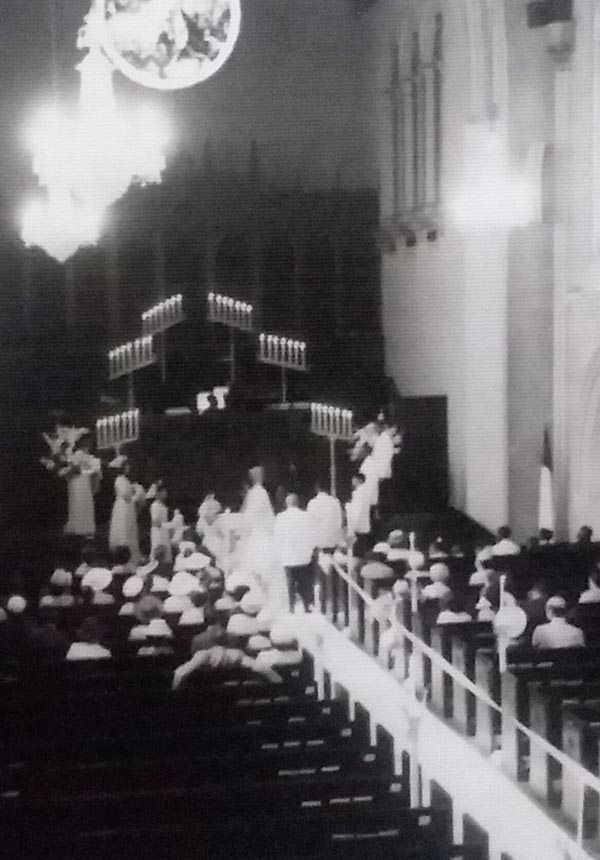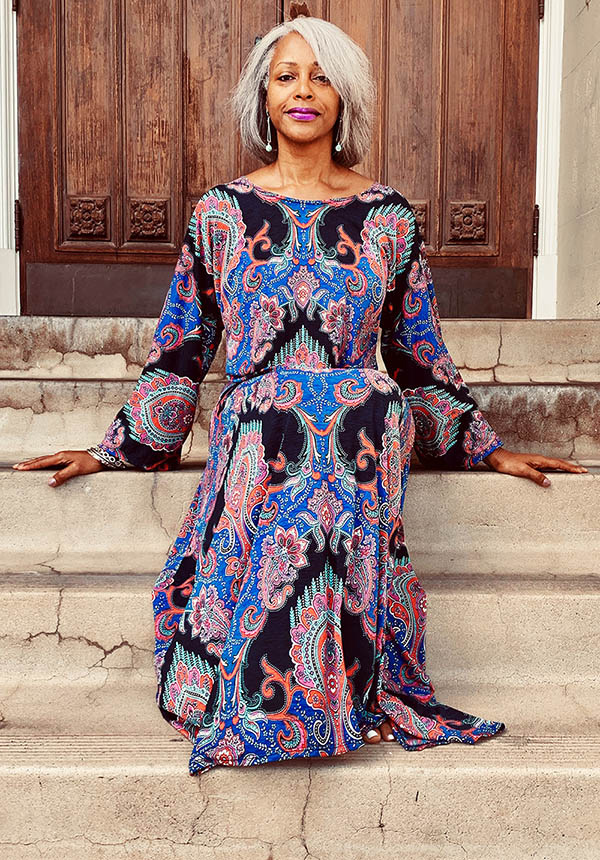It’s Easter Sunday when I arrive at the church more than an hour early for service, hoping for a moment of solitude. Instead, the choir is there rehearsing, He is Risen. I concentrate harder on the image in my mind: Here Comes the Bride.
Sitting in the back pew of McCarty Memorial Christian Church, I close my eyes and try to imagine my mother walking down the center aisle in her white gown and veil. Her uncle by her side. They walk arm-in-arm as they walked toward the alter where she would vow her life, love and fidelity to a young Marine in his dress blues who she’d known for less than a year, in a city she had lived in not much longer.
Being in this space makes the vision clearer.
This is the first time I have seen the sanctuary in color — giving a new context to the black and white wedding photographs I have in a small album, a keepsake passed down from my great-aunt. I’d driven by this church on Adams Blvd. for years, then several months I found myself drawn to the sanctuary where they were married 53 years ago this summer.

My parents on their wedding day in 1966… 
and on their anniversary in June 2019.
Mom was never shy about admitting that she didn’t like my father when she first met him. They worked in the same store: Boys Market on 11th and Hoover Street.
She’d gotten a job working in the non-foods department, General Merchandise as it was called, shortly after she had arrived in Los Angeles from Cleveland, Tennessee.
Dad is a native Angeleno, but was raised in Texarkana, Arkansas until he graduated high school; returning to the Southland the next day to forge a life away from the South. By the time he’d met my mother, he had recently graduated from Los Angeles Trade Technical College and was working as an electrician and part-time in grocery at the market. By the following year, along with more than 2 million men of the time, my father was eventually drafted to serve in the Vietnam War.
My parents’ initial connection is the stuff of a Hollywood rom-com meet-cute: He asked her out. She politely declined. He was too arrogant for her tastes, as she tells it, walking around the store like he owned the place.
“He acted like he thought he was a Goldstein,” she would say, giggling. The Goldsteins – brothers Al, Max, Bernard, Eddie and Joe — were the owners of the store where my parent worked – and 53 others in a chain of markets predominantly located in ethnic minority and immigrant communities.
Aunt Essie worked as a domestic in the Goldstein family home, while Uncle Louis worked in the meat department at one of the stores.
He hasn’t lost that confident swagger.
The two were at the market that hot summer night when the Watts Riots broke out on August 11, 1965. Despite being from the South where the nightly news of the time showcased civil rights protests and unfolding unrests in numerous cities, my mother had never been in such close proximity to the kind of violence that was now erupting through the streets.
Radio reports and gossip through the market from incoming customers told of an altercation between white Los Angeles police officers and a black motorist, Marquette Frye, suspected of drunk driving. Angry on-lookers and tensions escalated igniting six days of rioting in the area. By the end of the week, more than 34 people died, 1000 wounded, and an estimated $50 – $100 million in property damage throughout the working-class predominantly black neighborhood less than 12 miles away.
Mom didn’t have a car, and was afraid to take the bus. The news of fires, shooting and lootings around the area scared her. She lived in the West Adams district; Dad, in Venice. He was heading out to check on his sister, Marie, who lived in Watts, but offered to drop Mom off first, saying it was on his way. (It wasn’t.)
About six months later, he proposed. She said yes.
“That’s the way you meet somebody — when you not wanting to meet them,” Aunt Marie, said as she shared her recollections of my parents’ courtship a few months ago as we sat on the front porch of her home in Watts where she lived for more than 60 years.
Back at McCarty, one of the choir members waves to me from the front of the sanctuary. There are five women and eight men with microphones in front of the alter; not enough to fill the magnificent choir loft which, besides storage for a grand piano, doesn’t look as if it’s been used in decades.
For years I’d been saying I was going to come here — just to see; to bring a bit of my parents’ history to life in my mind. But there was always something else to do, other places to go on a Sunday morning. Then, as my family prepared for a grand vacation in the Dominican Republic to celebrate their anniversary, I began digging deeper into their story. And this time, I felt like I had to go.
Of course, the universe has a way of co-signing your intentions.
A week before my visit to McCarty, my mother and I were on the phone: Notre-Dame de Paris cathedral was burning. A structural fire had broken out the morning after Palm Sunday services were held, destroying the roof and spire and damaging its grand windows and vaulted ceilings. As Mom and I reminisced about the Palm Sunday service we’d spent there in 2005, it became clear to me that I needed to go to McCarty – a moment to my parents’ love story.

Church sanctuary on Wedding Day 1966 
Church sanctuary present day 2019
photo by Irene Yoon
On the steps of McCarty Memorial
photo by Irene Yoon
The church itself is pretty, yet weathered by years and neglect and, possibly, water damage. Drying palm branches are tucked into the corners of the pulpit; remnants of the previous week’s Palm Sunday service. The sanctuary is as it looks in the black and white photos. (Mom still laments not having splurged for color.}
Burnt orange, brick red, tan and the occasional forest green: the polished terra cotta square tiles that cover the flooring down the center aisle where my mother once walked. Some are embossed with varied religious symbols, including a Celtic cross and the Hindu swastika, its arms pointing clockwise to symbolize the sun — a sign of prosperity and good luck.
Neither one of my parents had been members of McCarty Memorial. Mom was raised Presbyterian; Dad, Church of Christ. And while she had been living with Aunt Essie and Uncle Louis, she’d been attending Mt. Sinai Baptist Church, but renting that space was out of her budget.
She found McCarty Memorial in the Yellow Pages. “They were advertising the space for weddings,” she told me. And, she said, the price was right. She attended a service there, liked it and booked it.
As I look at her face in the photograph, self-assured and a little trepidatious, I wondered what it was about my father that made her accept his proposal. “It was time,” was all my mother would say when I asked her years ago on their 30th wedding anniversary.
This year while we were on our family vacation this year, I was able to same question, only differently: “What was it about that man that made you want to take the risk?”
“For generosity, you can’t beat him,” she said as we chair
lifted to a ziplining platform overlooking the lush landscape surrounding Punta
Cana’s La Hacienda Park, my father in tow in the next chair. True to form, he’d
sprung for this nine-person family adventure tour, along with the vacation
itself — because it’s what Mom wanted.
She mentioned how much fun my dad was; she enjoyed accompanying him to company
picnics. He knew a lot about a lot, and could fix almost anything. There wasn’t
much more to it than that. “It’s worked out okay,” she said matter-of-factly, never
one caught up in outward sentiment.
When I asked them earlier on their 50th anniversary how they made it work: “Comprise,” my mother said. “Some things aren’t worth fighting over. You just have to decide to let it go.” Looking to my father, he nodded, “What your mother said,” with a sly smile and locking eyes with hers, acknowledging “yes, dear” are the two most powerful words a man must learn to have a happy ever after.
Of course, theirs is no fairytale marriage. I don’t know any marriages that are. What I’ve seen of theirs has been fostered as much by comprise and “yes, dears” as by intense clashes and hard work. Relationships can’t work without putting in the work.
In between, the photographs in the albums stored in the closets, nooks and crannies of their home tell a myriad of stories of risks taken, of cook-outs and family gatherings; life milestones encapsulated forever in smiles and goofy poses. It’s the story of their promises kept when they came to this church, and where I sit writing stories in a journal that I hope one day to share with my nieces and nephew when they’re older, and some day with their children.
Summertime (Or Anytime!) Fried Fish
My father loves to fish. Mom loves to cook. So, most every Littlejohn family gathering features fried, wild caught Red Snapper or Calico Bass — and these days many of my parents’ friends request it for their pot luck or food events. It’s that good, and deceptively simple to make.
Coat each piece in Louisiana Fish Fry which is a flavorful blend of corn meal, corn flour, garlic, salt and other spices. You can buy it, in bulk, at Smart & Final or in packets at local markets, including Ralph’s (which, coincidently, bought Boys Markets in 1988 for $103.7 million).
For thicker pieces, Mom advises adding a little Lawry’s Seasoned Salt or Beer Can Chicken seasoning from Weber to the fish before coating. “I like my fish salted, but not salty,” she says.
Fry in corn or vegetable oil, and serve hot with a side of salad and veggies, or as a sandwich. And, that’s it!
Yields 4 servings

Ingredients
•
1½ cups Louisiana Fish Fry (seasoned)
• Lawry
Seasoned Salt (if preferred)
• 3
cups of corn or vegetable oil
• 4
large fresh fileted red snapper (whole or cut into strips)
Instructions
- Rinse fish well in ice cold water. Use a paper town to soak up excess water.
- Lightly sprinkle salt over fish (if preferred); then roll in Louisiana Fish Fry Mix until coated.
- Deep fry fish in a cast iron skillet on high heat for a few minutes on each side until golden brown.
- Drain cooked fish on a paper towel to soak up excess oil. Serve hot.